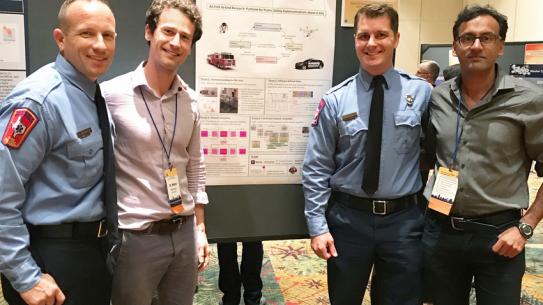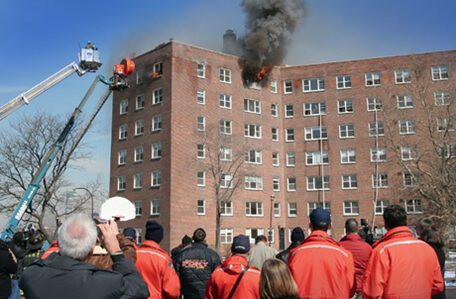Creating a safer world

Imagine that it’s 1895, and you’re a sailor in the U.S. Navy. If you were tasked with sentry duty on a moonless night, you’d be relieved that your ship was equipped with powerful searchlights, allowing you to spot looming dangers and sound the alarm; some of that vital equipment was the work of alum Edward R. Knowles (1870), who as the chief engineer at the Schuyler Electrical Company, was in charge of the design and development of all U.S. Naval searchlights. One of his models, showcased at the 1893 Chicago World’s Fair, could be seen for 125 miles, an astonishing feat at the time.
Knowles — who had helped construct the stone arches under the Manhattan approach to the Brooklyn Bridge before turning to electrical engineering — is just one in a long line of alumni and faculty members who have contributed to making the world a safer place.
Among the most celebrated of all has been Professor Ernst Weber. During World War II — a time when battles were won and lost based on which side could pinpoint enemy aircraft and ships quicker and more accurately — Weber, a member of the government-sponsored Office of Scientific Research and Development, created a device for the precise control of microwaves by coating glass tubes with a layer of conducting metal. That innovation proved instrumental to the development of modern radar systems, giving the allies a decided technological edge that helped win the war.
Redefining Emergency Response
Luckily many of us will never face peril at sea or on a battlefield, but an estimated 240 million calls are made to 9-1-1 in the U.S. each year seeking help for other dangers. And throughout the years, Tandon engineers have developed many new technologies to aid first responders.
In 2017, for example, NYU WIRELESS embarked on a project to jump-start technology that would enable first responders to relay video in moving ambulances, employ virtual reality in emergencies, receive high-definition images from drones in real time, and control robots in restricted indoor environments too dangerous for humans — tasks that seemed impossible at the time.
While ultra-fast 5G wireless was then becoming a commercial reality, its deployment still posed several challenges in the arena of public safety communications:
- In addition to covering land and air, emergency communications must also occasionally build their own networks, for example, when a hurricane takes down cell towers.
- Communication must be robust and reliable — link failures that mean nothing more than a dropped call for mobile phone users could be truly problematic in an emergency scenario.
- Emergency vehicles move rapidly — presenting a severe “handoff” challenge for antennae.
Thanks to funding from the U.S. Commerce Department’s National Institute of Standards and Technology (NIST), the researchers developed the first free and open-source channel sounding, emulation, and simulation tools for designing and testing public safety communications equipment — an important early step in bringing ultra-speed wireless connectivity to first responders.

Pinpointing an Emergency Location
It was Theodore Rappaport, Tandon’s David Lee/Ernst Weber Professor and the founding director of NYU WIRELESS, who developed the first E911 cell phone position location system.
You’ve probably watched at least one movie in which a calm 911 operator quickly dispatches a first responder to a precise location, despite the caller’s inability to state with any certainty where they are. That ability comes thanks to E911, a technology that allows operators to learn exactly which telephone number a wireless 911 call is coming from, the location of the cell site or base station transmitting the call, and the latitude and longitude of the caller. That ability to accurately pinpoint a person’s location has saved countless lives since its introduction.
A Matter of Time
In an emergency, every second counts. So in a pioneering effort to help provide faster, more equitable life-saving emergency services, researchers at C2SMARTER, Tandon’s DOT-sponsored Tier 1 University Transportation Center, are leveraging AI to help. With congestion an ever-present problem and the streetscape now featuring more protected bicycle and bus lanes, outdoor dining sheds, and other obstacles that make it difficult for fire trucks and ambulances to maneuver, NYU Tandon is providing practical, potentially life-saving traffic solutions.
Their innovative project, a first of its kind, involves using real-time traffic data from cameras and sensors, along with data from fire trucks and ambulances, to build a “digital twin,” a computerized replica of a New York City neighborhood that will enable researchers to understand the root causes of emergency response delays and test potential solutions before attempting them on actual streets.
The AI will do more than just mimic traffic conditions; it will predict and mimic how drivers respond to the flashing lights and sirens of emergency vehicles — and how emergency vehicles behave in the real world.
Researchers Get Fired Up
After 9/11, it became apparent that the firefighting community would be dealing with increasingly complex scenarios, their practices would need to incorporate modern scientific advances, and a deeper understanding of fire dynamics was sorely needed.
The NYU Fire Research Group at NYU Tandon, in partnership with FDNY and other organizations across the country, has conducted intensive research studies that have produced revolutionary changes in many long-established firefighting tactics. In 2008, for example, researchers conducted a series of live-burn experiments in an abandoned high-rise building at Governor's Island to study wind-driven high-rise fires. The results from those full-scale burn tests and scientific simulations provided a solid understanding of high-rise fire dynamics and the impact of wind on its behavior — work that had such an immediate and practical impact on the FDNY’s procedures that it was featured in the New York Times.

The Group has also helped develop a free, interactive scenario-based firefighter-training program that addresses a wide variety of topics including residential fires, wildland fires, and high-rise fires, to name just a few. ALIVE (Advanced Learning through Integrated Visual Environments) has been used by more than 75,000 firefighters from all 50 U.S. states and officially adopted by more than 1,000 fire departments nationwide.
Since firefighters obviously cannot train using live fire on a daily, weekly, or even a monthly basis, ALIVE gives them opportunities to learn — and make mistakes — virtually, without having to suffer real-life consequences.
Rescuing the Rescuers
While burns and smoke inhalation are often thought of as the greatest dangers in professional firefighting, sudden cardiac events like heart attacks are actually the leading cause of on-duty deaths. High stress, hostile temperatures and conditions, and heavy protective equipment: it all adds up to increased risks.
Now, thanks to the Fire Research Group, firefighters can download an app specifically developed for them. Fire Beats is an AI-based remote health monitoring system that analyzes the physiological data of firefighters using personal wireless wearable health trackers, evaluates cardiovascular risk factors, and alerts them to impending problems so that they can get timely aid.
Targeting the Firearms Ecosystem
No matter where you stand on Second Amendments rights politically, there’s widespread agreement that gun violence statistics in the U.S. are grim. As with any intractable issue, stemming gun violence starts with examining the data surrounding its causes ( — but until recently, the Dickey Amendment that precluded federal funding for firearm injury prevention research meant that few researchers tackled the subject.
Professor Maurizio Porfiri is one of the few who is working to meticulously build a trove of data that can be used for better decision-making. Deeply affected by the 2007 mass shooting that killed 32 people at Virginia Tech, where he had earned his Ph.D. just the year before, Porfiri wondered what he could do to help. As an expert in complex, dynamical systems, he discovered several challenges with studying gun violence, including a timing lag on reporting of key data and a complex web of interdependent factors that had not yet been untangled through the use of robust mathematical equations. He believed that engineering techniques could bring insight into gun violence that would guide policymakers in making evidence-informed decisions.
In 2020, he became the first researcher to receive a grant from the National Science Foundation earmarked specifically for gun-related studies, which allowed him to focus his attention on what he terms the “firearm ecosystem” — an intricate interplay involving individual behavior, state-level policies, and national dynamics.

Among his findings have been several that challenge conventional wisdom, suggesting new possible solutions. His team’s investigation into the correlation between mass shootings and firearm sales, for example, found that contrary to popular belief, fear or protective instincts did not significantly influence gun purchases after mass shootings. Instead, Porfiri’s research identified a strong causal link between media coverage of potential gun regulation and increased firearm sales. Individuals appeared to purchase guns in response to concerns about potential restrictions, sparked by media stories around regulatory measures. This insight lends weight to efforts to maintain a steady drumbeat of media discussion around gun regulation, rather than just when tragic events occur.
More recently, he determined that fame-seeking mass shooters — as opposed to those motivated by personal grievance or revenge, for instance — attempted to draw outsized attention to themselves by deliberately choosing unique targets and locations for their crimes–rather than by maximizing casualties as had previously been assumed.
He has also combined data from the U.S. government, police departments, media and other sources to create a model that predicts monthly gun homicide rates — up to one year out — with better accuracy than techniques researchers typically use. The model also “backcasts” as recently as one month prior, a significant achievement considering the federal government’s official monthly gun death data can be nearly two years old when it is released.
Thanks to Porfiri’s sophisticated mathematical modeling, policy makers are gaining access to vital, up-to-date and accurate information that could result in improved safety for all.

